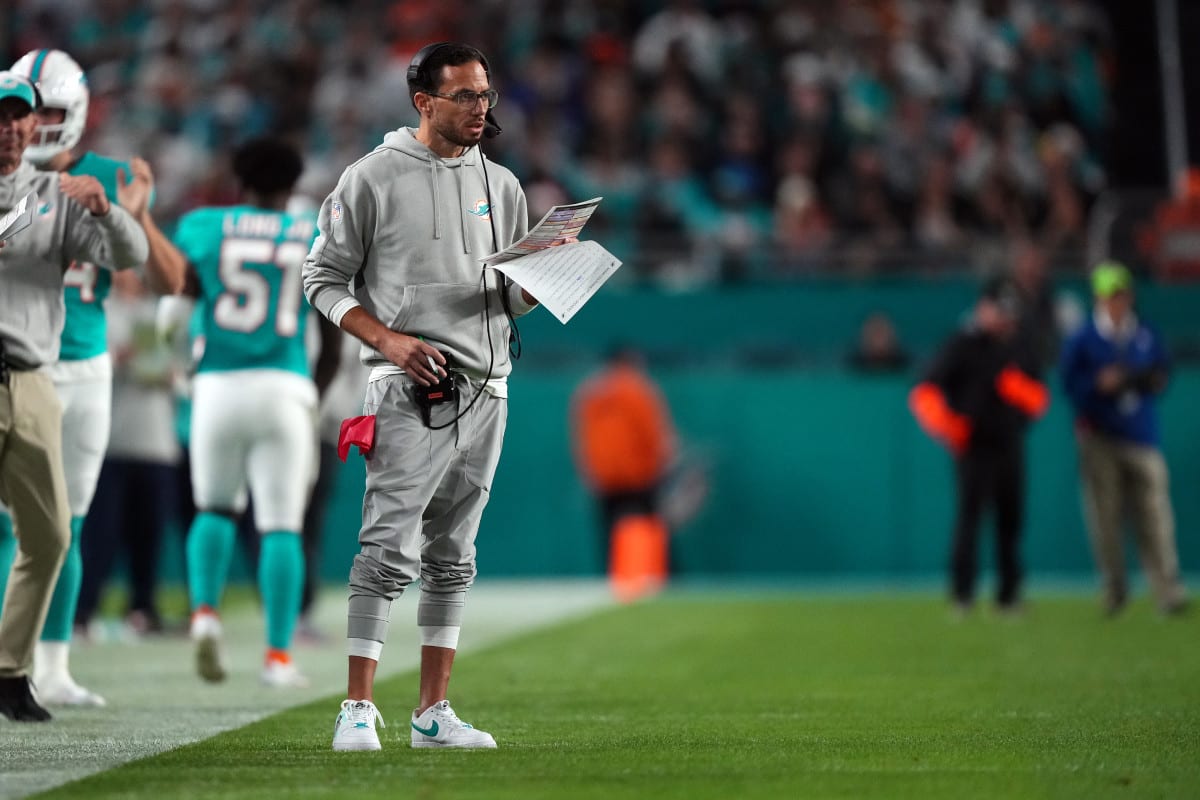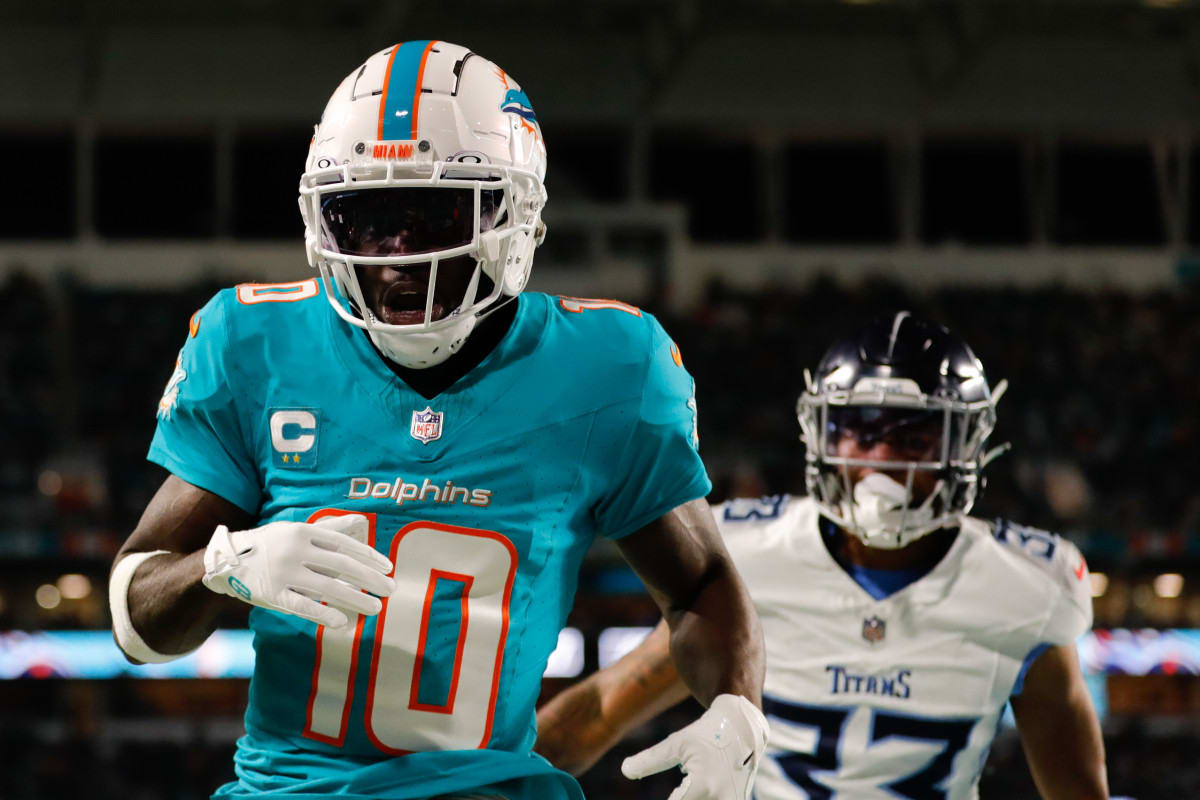The reason why Tyreek Hill should not play Sunday is specifically because of what happened when he returned from injury Monday night against the Titans.
The Dolphins were clearly ignited by Hill’s reemergence, juxtaposed with what we saw when Hill was receiving treatment or resting on the sideline. On the team’s first drive without Hill, the Dolphins leaned heavily on the run game. On Tua Tagovailoa’s one true drop-back of the drive—a second-and-14 following an Arden Key sack stemming from a missed pull block by a tight end—the quarterback spent more than five seconds in the pocket before chucking an incomplete pass.
In between, Miami had to rely on a running game that, with both of its lead backs, was averaging more than six yards per carry. Coach Mike McDaniel even rolled out one of my favorite motion concepts, bringing De’Von Achane to the opposite side of the quarterback before daggering him on a downhill run in the direction from which he came. Just that small backfield gesture completely shifted the positioning of Tennessee’s linebackers.

Jasen Vinlove/USA TODAY Sports
As a whole, Miami was much less dynamic in terms of the presnap theatrics. Outside of a Braxton Berrios orbiting motion pattern that was designed for him to receive a quick pass off the snap, there wasn’t much of an attempt to rattle the Titans before the snap. There also, understandably, were not a lot of instances in which Tagovailoa was put in a classic drop-back situation until the next drive, a two-minute situation.
On that second drive without Hill, Tagovailoa’s snap-to-throw times (by my count) were: 5.31 and 6.13 seconds. After the half, the Dolphins started the first drive with a pair of runs before Tagovailoa lofted a beautifully placed ball to Cedrick Wilson Jr. down the sideline. Wilson made a phenomenal catch, with the arm of the Titans corner intermingled with his own. That third-down pass took just 1.91 seconds to get off.
It took Tagovailoa a minute to get there, but that throw seemed to awaken the best of the quarterback. On the next play, he went back to Wilson on a quick one-step drop. A few plays later, he identified a clear pass interference situation and took a deep shot (also to Wilson) that drew a flag. The Dolphins tied the game with a field goal on that drive.
This is a long way of saying that Tagovailoa learned to operate well enough without Hill, and the Dolphins got to flex a clock-draining run game that was still effective. It showed that Miami can win games—even though, of course, the Dolphins allowed 15 points late to lose Monday—and move the ball without their potential MVP candidate at wide receiver. It also showed how much easier (cringe word, I know, as no snap in the NFL is easy) life is when Hill can be in the lineup.
Once Hill got back, Tagovailoa’s entire field of vision changed. Even as a decoy, Hill is stupefyingly effective. Tagovailoa missed a pair of throws—a shorter one to Durham Smythe and a deep shot to Achane—that were open specifically by Hill’s presence. He was catching deep balls and gaining yards after the catch. It’s a bit like having Tagovailoa go from riding a real bicycle to an electric one, in which some of the propulsion is automated and some of the physical (and mental) stress is taken off his back.

Sam Navarro/USA TODAY Sports
So, outside of throwing Hill off pace for the 2,000-receiving-yard season, and risking potentially moving one more game behind the Ravens in the AFC playoff picture, what is the true penalty for allowing Hill to rest his ankle for another week and ensure the Dolphins have him for a playoff run?
I would argue that there is a benefit: Forcing Tagovailoa to play against a good Jets defense without his star receiver will expedite the process of Tagovailoa reaching that level of in-rhythm comfort without a scheme-altering threat. It also, like the Bengals saw when Joe Burrow was injured, will force the team to double down on its running game and find some unfamiliar advantages.
If the Dolphins are going to make a deep playoff run, Hill must be as close to 100% healthy as possible; the Dolphins’ offensive line must be playing as close to perfect as possible; and Tagovailoa must make plays when Hill is lost in coverage, or if Hill is not on the field at all. Resting Hill ensures that more work is put into the latter two and is the only way to ensure the first.
An ankle issue for a player who routinely starts a snap in a kind of ninja crouch and then springs up into a full sprint is different from an ankle injury for just about any other position. I applaud Hill’s toughness and was somewhat amazed at how quickly he was able to storm back into Monday’s game against the Titans before exiting again.
But if rest happens to coincide with the improvement of the offense without Hill (and, undoubtedly, the improvement of the offense overall when Hill returns), I see no reason to play him Sunday.







